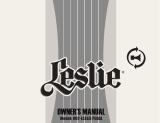
3
INTRODUCTION
Designed as a creative tool, the Radial X-Amp is an active re-
amplifying device that allows prerecorded instrument tracks
to be sent through guitar amplifiers and effect devices.
Although the Radial X-amp is new, the process of re-amping
tracks has been around for years. Historians credit jazz
guitar great Les Paul as the first to employ the concepts of re-
amplifying sound in the 1950s as there was no other way to
double tracks or create echo effects. In the 1960s, Phil
Spector’s work with the Beatles and his famous ‘wall of
sound’ employed re-amping techniques. In the 1970s, Roger
Nichols built his own ‘Reamper’. Roger used it on all of the
Steely Dan records virtually burning out tubes in effort to get
the right sound. Only today with the proliferation of affordable
high quality multi-track recording has the demand for high-
quality recording tools allowed manufacturers to develop
devices such the X-amp into commercially viable products.
To use the X-Amp, one would generally record a dry guitar or
bass track using a direct box such as the Radial JDI, Radial
J48 or Radial JDV and then play the pre-recorded track ‘back’
through the X-Amp, which in turn would then be connected to
a guitar amplifier. The advantages of recording a track this
way are many: During session work, once the original track
has been recorded, the engineer and producer can try
different amplifiers and sounds without tiring out the player
with relentless repetition. For the player-engineer, the track
can be recorded, then the player can then sit in the control
room and listen to a variety of guitar effects or amplifiers
before committing a final sound to the track.
Since guitar amps and recording devices work at different
signal levels, they are not directly compatible. In essence, the
X-Amp allows these devices to ‘speak’ to each other. The
Radial X-Amp is an active ‘impedance and level-matching
device’ that converts line level signals from a mixing console
or tape recorder to guitar level signals to drive one or two
guitar amplifiers without introducing ground-loops or noise.
The X-Amp can also be used on other instruments: Keyboard
tracks can be given extra life by warming up their sound by
sometimes driving them through distortion pedals or tube
guitar amps. Vocal tracks can also be twisted into new
sounds by introducing these fun effects. And this is just the
beginning!
The real advantage of the X-Amp is the amazing clarity and
natural tone. Unlike previous re-amping devices, the Radial X-
Amp is active. The X-amp features our unique Class-A circuit
(the same as used in our highly acclaimed Radial JD7 Injector)
to ensure every subtlety is transferred to the amplifier without
harsh harmonic distortion, virtually zero phase distortion and
exceptionally low inter-modulation distortion.
True to the Music
X•AMP User Guide
Radial Engineering


























